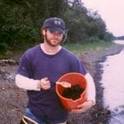
Article
Keystone Interactions: Salmon and Bear in Riparian Forests of Alaska
Ecosystems
(2006)
Abstract
The term "keystone species" is used to describe organisms that exert a disproportionately important influence on the ecosystems in which they live. Analogous concepts such as "keystone mutualism" and "mobile links" illustrate how, in many cases, the interactions of two or more species produce an effect greater than that of any one species individually. Because of their role in transporting nutrients from the ocean to river and riparian ecosystems, Pacific salmon ( Oncorhynchus spp.) and brown bear (Ursus arctos) have been described as keystone species and mobile links, although few data are available to quantify the importance of this interaction relative to other nutrient vectors. Application of a mass balance model to data from a southwestern Alaskan stream suggests that nitrogen (N) influx to the riparian forest is significantly increased in the presence of both salmon and bear, but not by either species individually. The interactions of salmon and bear may provide up to 24% of riparian N budgets, but this percentage varies in time and space according to variations in salmon escapement, channel morphology and watershed vegetation characteristics, suggesting interdependence and functional redundancy among N sources. These findings illustrate the complexity of interspecific interactions, the importance of linkages across ecosystem boundaries and the necessity of examining the processes and interactions that shape ecological communities, rather than their specific component parts.
Keywords
- Salmon,
- Bear,
- Riparian forest,
- Marine-derived nutriends,
- Nitrogen,
- Keystone species
Disciplines
Publication Date
March, 2006
Publisher Statement
Published by: Springer Stable URL: http://www.jstor.org/stable/25470328
Citation Information
James M. Helfield and Robert J. Naiman. "Keystone Interactions: Salmon and Bear in Riparian Forests of Alaska" Ecosystems Vol. 9 Iss. 2 (2006) Available at: http://works.bepress.com/helfield_james/5/
